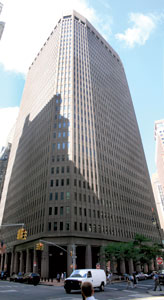Over its 27-year lifespan, 85 Broad Street in Lower Manhattan has been described in an assortment of ways: “forgettable” (the New Yorker), “desperately anonymous” (the New York Observer), and “institutional” (the New York Times). Nowadays, however, any descriptions of the 30-story former home of Goldman Sachs can be distilled down to a single adjective: empty.
As of last month, 85 Broad — with its nearly 1.1 million square feet of available space — has assumed the luckless title of Manhattan’s largest vacant block of available space on the market. Since April, when Goldman Sachs completed its move to a new 43-story building at 200 West Street, the building has literally become a shell of its former self.
While powerful Goldman executives such as Hank Paulson and Robert Rubin, who both went on to serve as Treasury Secretary, and former New Jersey Governor Jon Corzine once roamed the halls, nowadays 85 Broad is home to only a handful of security guards, maintenance workers and the occasional broker showing the space.
A tour of the executive and former trading floors — led by Jones Lang LaSalle broker Dan Suozzi — revealed the vestiges and detritus of the building’s former glory: the fading “Goldman” emblem over the receptionists’ desk; an abandoned treadmill in the bathroom outside an executive suite; packaged Riedel wineglasses; china in the cafeteria; and a message scrawled on a chalkboard inside the executive kitchen that reads, “goodbye. thanks for the memories.”
But the banking giant is still paying rent for its former headquarters and will continue to do so until the middle of next year.
Nonetheless, several questions linger: What fate will befall such a storied, if unremarkable, building? And, perhaps most important, what is the interplay between the future of 85 Broad and that of its immediate surroundings in Lower Manhattan, which have more available office space coming online over the next 12 months than any other part of Manhattan?
“To some extent, yes, a building of this scale has to sell itself,” said Jones Lang LaSalle’s president of New York operations, Peter Riguardi, who is serving as the leasing agent for the building’s owner, MetLife.
Riguardi would not divulge many details, but said he has been heartened by the amount of showings and proposals he has received recently. He noted that the drop in pricing for that market has made 85 Broad available to a wider range of tenants beyond just financial firms. Media, publishing, legal, advertising and insurance companies have all called to inquire.
“We are seeing every type of tenant,” Riguardi said.
Riguardi’s team is showing the building to two to three prospective tenants a week and is looking for an anchor tenant that will assume several hundred thousand square feet. Goldman declined to comment. And a spokesperson for MetLife said only that the building has seen “considerable” interest, but that no deals have been signed.
Despite his optimism, Riguardi and his team face an array of challenges. Start with the asking price. JLL has listed the building’s premier space at $50 a square foot, about a 30 percent markup from the $38-per-square-foot average Downtown registered in May, according to CBRE.
The firm must also contend with more than 5.9 million square feet of unused office space that was added to the Lower Manhattan market during the 12-month period ending in April, according to Cushman & Wakefield. Other large blocks of space have been vacated by finance and insurance companies at 70 Pine, 40 Wall Street, 125 Broad Street and 77 Water Street.
And then there’s One World Trade Center, the 1,776-foot tower under construction that is reportedly attracting interest from companies 85 Broad would probably be happy to welcome as new tenants, such as Condé Nast and Bank of New York Mellon. The building, when complete, will have 2.6 million square feet of space.
All of this makes Riguardi’s task at 85 Broad even harder.
Goldman has occupied the building since its inception and signed a three-year extension in 2008, leaving MetLife with the benefit of the continued rent. But a protracted vacancy can sometimes be its own challenge. Take Worldwide Plaza — another Skidmore Owings & Merrill-designed building — which has been unable to break out of a rate of less than 50 percent occupancy for more than a year now, according to CoStar.
“Eighty-five Broad has a tremendous amount of competition,” said James Frederick, executive managing director at the commercial services firm Cassidy Turley. But he said 85 Broad also has clear advantages. “There are some big blocks, but nothing that competes with 85 if you are looking for strong infrastructure. The World Financial Center space will certainly be competitive, but those leases don’t expire till 2013. In today’s market, that is probably the best block of space.”
There are a number of corporate tenants in need of space that would appear to be a good fit. As The Real Deal recently reported, as of June there were 51 tenants on the hunt for more than 100,000 square feet, including law firm Milbank, Tweed, Hadley & McCloy, which is reportedly looking for more than 300,000 square feet.
“If a ‘C’ grade tenant came and was looking at other ‘C’ grade buildings, we are not going to be competitive with that,” said Riguardi. “But for the high-quality tenants looking at the few high-quality spaces Downtown, we are absolutely going to be competitive.”
During the blackout of 2003, the employees at Goldman were some of the few who continued working, thanks to 85 Broad’s internal generators, something often mentioned by the leasing agents.
The question now is, who will be the next firm to turn those same lights back on — and when?
